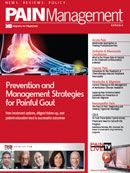Publication
Article
Pain Management
Does the FDA Blame Physicians for the Prescription Opioid Abuse Epidemic?
Publisher's note, August 2012.
It's no secret that the country is awash in prescription opioids. IMS Health estimates that there were nearly 23 million prescriptions for extended-release/long-acting opioid analgesics dispensed in 2011, and that more than 320,000 prescribers registered with the DEA wrote at least one prescription for extended-release opioids in 2011 (http://bit.ly/Nb01sk). The sheer volume of medications available has contributed in large part to the increase in abuse and misuse, with some surveys indicating that up to 70% of people who used opioids for non-medical reasons obtained them from friends or family members who had been prescribed the medications by a physician.
The recently announced class-wide REMS for long-acting opioid medications will attempt to curb this abuse through increased prescriber and patient education. It is hoped that making available continuing education programs for prescribers and “patient counseling documents” and medication guides for patients will improve their understanding of the risks and benefits associated with these medications, leading to smarter, more appropriate treatment choices.
Nobody at the FDA will say it, but the opioid REMS effort basically boils down to “We want clinicians to write fewer prescriptions for long-acting opioids.” Instead we get statements like “Educating health care professionals on how to safely prescribe the drugs is essential to address this critical public health issue… Equally important, patients must know how to use these drugs safely” from FDA Commissioner Margaret A. Hamburg, MD (http://bit.ly/NJlNse).
What this statement implies is that a large percentage of physicians currently do not know how to safely prescribe this class of opioids, despite the attention paid to this issue over the last several years. Does this also mean that the FDA and other agencies think that, because of this lack of understanding of how to properly weigh the risks and benefits of these medications, many physicians have been inappropriately prescribing opioids to patients who either don’t need them at all, or at least don’t need them in the quantities prescribed?
Because the FDA does not currently have the authority to mandate training for physicians, the REMS plan only calls for educational programs to be created and made available at no cost to prescribers. It also does not (wisely, in my opinion) do anything to actively restrict opioid dosing, availability, or duration of treatment, as was requested in a petition recently sent to the FDA by a group of “leading pain-addiction experts and prominent health officials” (http://on.wsj.com/OJsQ2i).
The question now is how these industry-funded educational efforts to make doctors and patients more aware of the risks and benefits of opioids will be received, and what effect they will have on prescribing. The CME programs called for under the REMS program will be required to stress “appropriate prescribing practices” and proper patient assessment (ie, determining whether a given patient really need opioids). But, if the programs effectively convey these messages to doctors, who then change their practice habits because of them, it will by definition result in fewer prescriptions written for extended-release opioids.
We now find ourselves in a situation in which the general consensus is that opioids have legitimate medical uses and bring needed analgesia to millions of patients, but also that current prescribing patterns have to change in order to prevent abuse and misuse. The structure of the final REMS program indicates that the FDA and the pharma industry view this as mostly a supply and distribution problem that can be addressed through non-mandatory educational efforts.
If that be the case, then what would constitute “success” for this endeavor? What percent reduction in opioid overdose deaths/emergency room visits/ admissions to treatment programs would indicate that this approach is working? And how many fewer opioid prescriptions will have to be written to accomplish that?






